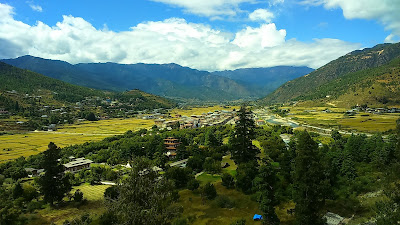 | |
| Bhutan - October 2015 |
The bottom line is often emphasized as what's most important in any economy, unless you happen to find yourself in Bhutan – a country where delight is valued as much as dollars.
This Himalayan Shangri-La – wedged between China and India – rejects the GDP (Gross Domestic Product) model of prosperity in favor of its own GNH (Gross National Happiness).
The idea is that Bhutanese leaders should maintain a society where "material and spiritual development happen together", thus creating the best environment for citizens to be happy. It's the only country in the world that utilizes such a holistic, non-monetary measure of the quality of life.
With this aim in mind, the government puts environmental conservation at the heart of decision making – 60% of the country must remain forested; the country has pledged to be carbon neutral; and tourism is limited because of a US$250-per-day-fee per guest, which includes hotels, meals, transportation, and a guide. All travel – with the exception of three nationalities – is organized through agencies.
I relish the reduced cost and increased independence of backpacking, but it gives a traveler a good feeling knowing $65 of that daily fee goes toward education, healthcare, and roads. Plus, the accommodations are generally quite comfortable and the food tasty.
Bhutan is about the size of Indiana or Switzerland with a population of 750,000 inhabiting 15,000 square miles.
For centuries, this predominately Buddhist country remained closed to visitors. In 1974, the first tourists arrived, followed two decades later by television and the internet when in 1999 the king finally lifted the ban outlawing both activities.
There's plenty to see in Bhutan: ancient fortresses,
one of the world's largest Buddhas,
and the country's most famous attraction –
the Tiger's Nest Monastery, tucked into a cliff 3,000 feet above the valley floor.
You'll have to hike more than two hours to reach the 10,240-foot elevation, but it's well worth the effort for the view alone.
If you're lucky, you also might be able to partake of a traditional festival
featuring dozens of colorful, mask-clad dancers.
Bhutan is one of my all-time favorite destinations.
Thimphu is the world's only capital city without a traffic light.
But there's a downside to paradise.
For travelers, the $250-per-day-fee adds up quickly, although the fee drops to $200 a day in the off-season.
In addition, getting around isn't easy. Roads between towns are being upgraded, but you're likely to find the journey bone-jarring at times with numerous delays, ranging from construction to landslides to trees being cut down.
And the take off and landing at the country's only international airport can be a bit nerve-racking. Paro is considered to be one of the world's most dangerous airports because of strong winds, the treacherous terrain, and a series of hard, last-minute banks during the approach. Only eight pilots are qualified to fly here.
Take a look at this aerial video from You Tube.
Finally, despite its reputation for happiness, Bhutan is far from perfect for those who live there. The government's decision to open the borders has led to numerous social problems in the developing nation, including crime, drug abuse, and unemployment.
Still, it's wonderful to spend a few refreshing, romantic days in the Himalayas in a land where anything seems possible,
and money isn't the main preoccupation in life.
Note: Bhutan requires tourists to book vacations through one of more than 1,000 travel agencies. I can't say enough good things about Swallowtail, which we found on Trip Advisor. Unlike most countries, Bhutan asks visitors to pay upfront before visas and airline tickets are issued. Don't be alarmed. That's just the way it's done.












